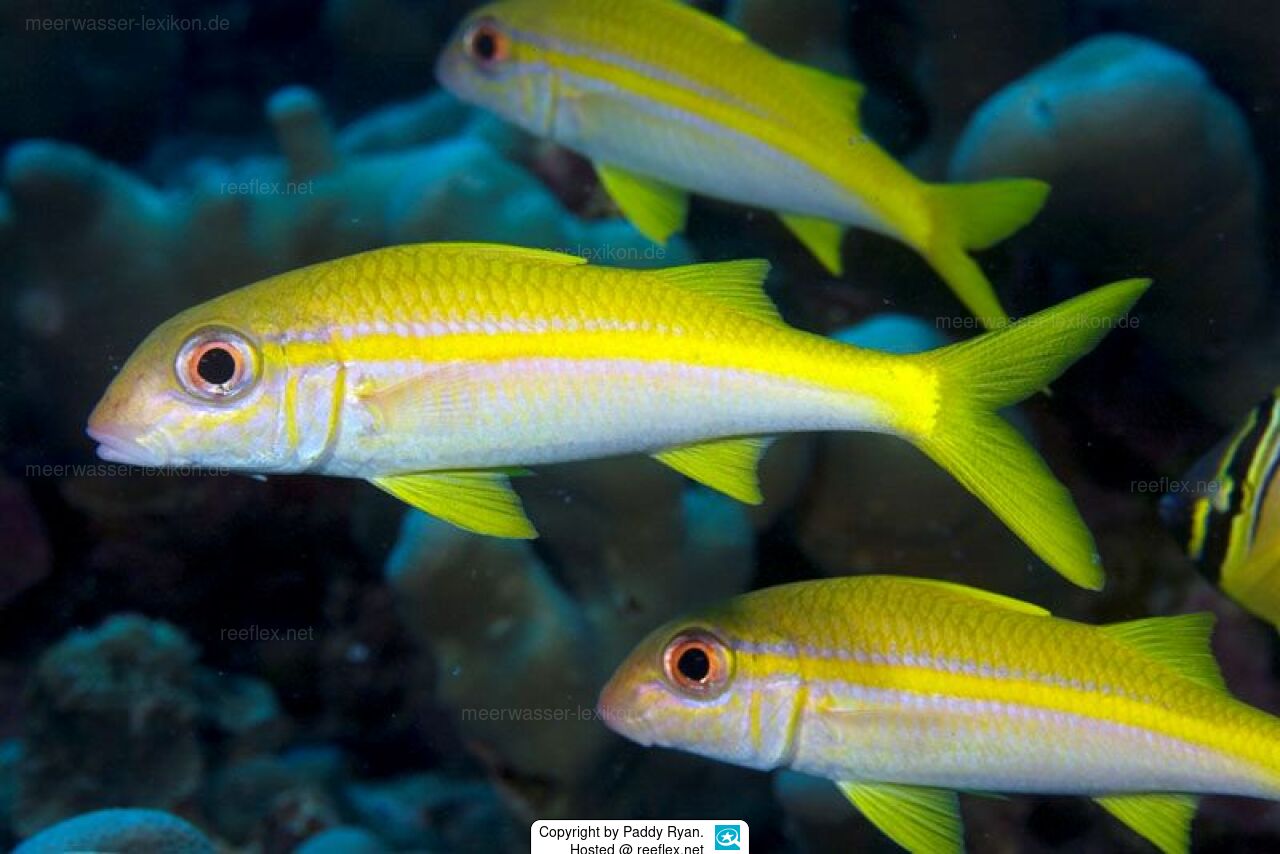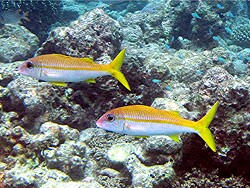Info
Mulloidichthys vanicolensis (Valenciennes, 1831)
The back of the large-school barb is red-orange, while the sides and belly are whitish and the fins are yellow. The sides have a yellow longitudinal band.
During the day, Mulloidichthys vanicolensis forms large schools and inhabits the sandy bottom of reefs, lagoons and reefs in the sea. Feeds at night on small worms and crustaceans.
Mulloidichthys vanicolensis is sold at a fish market in New Caledonia.
Mulloidichthys vanicolensis is infested by numerous parasites: the gill parasites Volsellituba and Pennulituba, with a total of five different species, including Volsellituba orchidea, Volsellituba nabla, Volsellituba elephantina, Pennulituba piratifalx and Pennulituba cymansis, have been reported in the yellowfin mullet off New Caledonia and have apparently only been found in this species of fish. The apocreadiid Digenea Homalometron moraveci is found in the gut of Mulloidichthys vanicolensis.
Synonymised names
Mullodichthys vanicolensis (Valenciennes, 1831) · unaccepted > misspelling - incorrect subsequent spelling
Mulloides erythrinus Klunzinger, 1884 · unaccepted
Mulloides vanicolensis (Valenciennes, 1831) · unaccepted
Mulloidichtys vanicolensis (Valenciennes, 1831) · unaccepted (misspelling)
Pseudopeneus vanicolensis (Valenciennes, 1831) · unaccepted
Pseudupeneus vanicolensis (Valenciennes, 1831) · unaccepted
Upeneus vanicolensis Valenciennes, 1831 · unaccepted
The back of the large-school barb is red-orange, while the sides and belly are whitish and the fins are yellow. The sides have a yellow longitudinal band.
During the day, Mulloidichthys vanicolensis forms large schools and inhabits the sandy bottom of reefs, lagoons and reefs in the sea. Feeds at night on small worms and crustaceans.
Mulloidichthys vanicolensis is sold at a fish market in New Caledonia.
Mulloidichthys vanicolensis is infested by numerous parasites: the gill parasites Volsellituba and Pennulituba, with a total of five different species, including Volsellituba orchidea, Volsellituba nabla, Volsellituba elephantina, Pennulituba piratifalx and Pennulituba cymansis, have been reported in the yellowfin mullet off New Caledonia and have apparently only been found in this species of fish. The apocreadiid Digenea Homalometron moraveci is found in the gut of Mulloidichthys vanicolensis.
Synonymised names
Mullodichthys vanicolensis (Valenciennes, 1831) · unaccepted > misspelling - incorrect subsequent spelling
Mulloides erythrinus Klunzinger, 1884 · unaccepted
Mulloides vanicolensis (Valenciennes, 1831) · unaccepted
Mulloidichtys vanicolensis (Valenciennes, 1831) · unaccepted (misspelling)
Pseudopeneus vanicolensis (Valenciennes, 1831) · unaccepted
Pseudupeneus vanicolensis (Valenciennes, 1831) · unaccepted
Upeneus vanicolensis Valenciennes, 1831 · unaccepted







 Dr. Paddy Ryan, USA
Dr. Paddy Ryan, USA


















